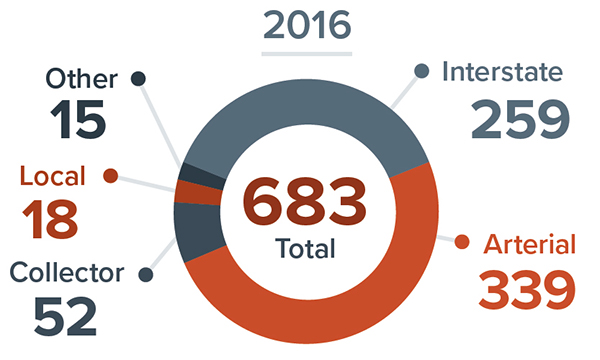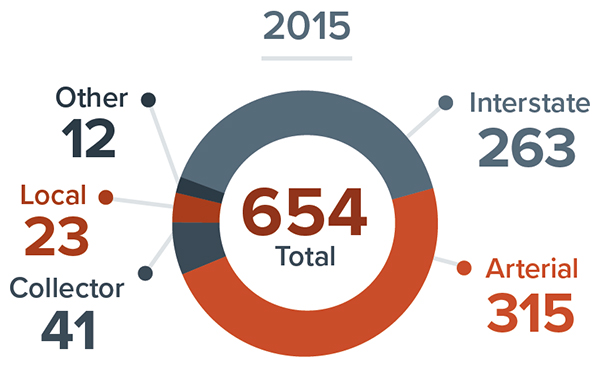Work Zone Safety: Everybody's Responsibility
Printable Version [PDF, 240 KB]
You may need the Adobe® Reader® to view the PDFs on this page.
Contact Information: Operations Feedback at OperationsFeedback@dot.gov

U.S. Department of Transportation
Federal Highway Administration
Office of Operations
1200 New Jersey Avenue, SE
Washington, DC 20590
FHWA-HOP-18-044
2018 National Work Zone Awareness Week
April 9—13
Work zones play a key role in maintaining and upgrading our nation's roadways. Unfortunately, daily changes in traffic patterns, narrowed rights-of-way, and other construction activities often create a combination of factors resulting in crashes, injuries, and fatalities. These crashes also cause excessive delays, especially given the constrained driving environment.
Work zone incidents impact everyone. In addition to vehicular crashes and fatalities, the leading cause of death in the road and bridge construction sector are run overs, back overs, and falls. Simply put: drivers, passengers, and construction workers are all at risk. Your driving habits can directly help—or harm—the well-being of other motorists, cyclists, workers, and pedestrians, including you.
It's important for everyone to do their part to improve work zone safety. Work zone safety is everybody's responsibility.
- Drivers, bikers, motorcyclists, and pedestrians should always be alert, obey traffic laws and signs, and pay attention to their surroundings.
- Passengers should always buckle up, act responsibly, and avoid distracting the driver.
- Field workers must always implement safety best practices when actively working in construction zones.
- Emergency responders must be able to respond to and secure crash locations.
- Police and courts are responsible for enforcing traffic and work zone laws.
- Local and state governments should promote safe roads and increase public awareness about work zone safety.
Tips for Driving Safely in and Around Work Zones
Visit the FHWA Work Zone Management website at https://www.fhwa.dot.gov/workzones and the National Work Zone Safety Information Clearinghouse website at https://www.workzonesafety.org/ for access to resources, guidance, and training.
- Know Before You Go. Check your phone apps, agency websites, and the radio for the latest traffic information to ensure a safe and timely trip.
- Wear Your Seatbelt. It is your best defense in a crash.
- Expect the Unexpected. Work zones change often. The area you drove through yesterday may look different today.
- Avoid Distractions. Distracted driving in a work zone can have deadly consequences. Put down your phone and keep your eyes on the road.
- Pay Attention to Other Drivers. Narrowed traffic patterns provide less ability to maneuver around other vehicles safely. Paying attention can prevent the need for evasive actions in work zones.
- Don't Speed or Tailgate. Keep a safe distance from the vehicle ahead of you and don't speed. Tailgating and speeding lead to crashes with other vehicles and field workers.
- Obey Road Crews and Signs. Flaggers know how best to move traffic safely in work zones. The warning signs are there to help you and other drivers move safely.
- Be Patient and Stay Calm. Work zone crew members are working to improve the road and make your future drive better. Stay calm and drive safely.
TOTAL WORK ZONE FATALITIES by transportation mode*
| 2016 | 2015 | % Change | |
|---|---|---|---|
| 765 | 712 | 7% | |
| Drivers and passengers |
635 | 595 | 7% |
| Pedestrians and bicyclists |
125 | 113 | 11% |
| Others |
5 | 4 | 25% |
| 2016 | 2015 | |
|---|---|---|
| Worker fatalities in road construction sites** |
143 | 130 |
| Fatal work zone crashes involving large trucks and buses* |
186 | 177 |
| Work zone fatal crashes where speeding was a factor* |
190 | 187 |
TOTAL WORK ZONE FATAL CRASHES by type of highway*
Sources:
*Fatality Analysis Reporting System (FARS) 2015 Final and 2016 Annual Report File, National Highway Traffic Safety Administration (NHTSA). FARS data shown here are from the 50 states, the District of Columbia, and Puerto Rico.
**2015 and 2016 U.S. Department of Labor, Bureau of Labor Statistics, in cooperation with state, New York City, District of Columbia, and federal agencies, Census of Fatal Occupational Injuries.
Note: Figures are subject to revision, as values reported in FARS may be updated intermittently. Values shown here reflect what is reported by NHTSA as of March 2018.

